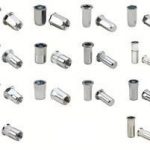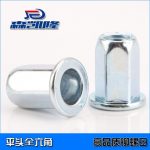Types Of Rivet Nut (INSERT NUT)
STAINLESS STEEL (SS)
MILD STEEL (MS)
ALUMINUM
Download the India Fastener Mobile Application
1. Pick the right rivet nuts.There are two types of rivet nuts: The first is designed to form a bulge on the application’s blind side as the screw, pin, or bolt is tightened. The second is pulled into a sleeve and thus doesn’t bulge like the other type. So how do you know which to use? It depends on your application. Here are some features and styles to consider:
- Wide front-side flange: This rivet nut feature offers a large load-bearing surface to both reinforce the hole and keep the Insert Nut from being pushed through.
- Thick flange: This feature can provide spacing and extra push-out strength.
- Countersunk/low-profile head: With this feature, you ensure an installation that is nearly or completely flush.
- Wedge head: Wedges underneath the head keep the fastener from turning in the hole by “biting” into the mating material. This feature is great for soft materials such as plastic, fiberglass, or aluminum.
- Shape: Rivet nuts come in splined, square, hexagonal, and the standard smooth, round cylindrical style. Each style is meant to keep the fastener from turning at high torque levels, especially in softer materials.
- Open or closed: Rivet nuts come in open- and closed-end styles, with the latter preventing water and dust getting into the assembly, such as with an automotive installation.
- Thin or thick wall: Whereas thick wall rivet nuts (also known as standard style) offer keyed heads, thin wall rivet nuts do not.
If you’re not sure what kind of rivet nut you need for your application, seek out a fastener expert so all necessary project variables are met.2. Use in countless materials.Rivet nuts are easy-to-install, reliable fasteners that can provide strong load-bearing threads into weak or thin gauge materials such as castings, housings, panels, tubes, and extrusions. Additionally, because of their wide grip range tolerance, rivet nuts can be installed into a variety of material thicknesses.3. More practical than other fasteners.Made from aluminum, stainless steel, steel, brass, and Monel, rivet nuts offer a variety of benefits over bolts, self-tapping screws, and pressed inserts. In fact, rivet nuts are not impaired by heat, unlike other fasteners such as weld nuts. Many times, installing rivet nuts is just more practical in comparison to other available fasteners.4. Perfect for your industry and application.These fasteners are designed to be automated and are used widely throughout the automotive industry to attach items to dashboards, as well as in the chassis and bodywork to connect roof racks, spoilers, plastic fenders, radiators, and more. Rivet nuts are also perfect for every stage of production with no reworking needed after insertion—even when the workpiece has already been coated or painted. Some other industries and applications:
- Refrigerators
- Playground equipment
- Office furniture
- Solar panel installation
- Medical technology
- Plastics engineering
- Electronics
- Bicycles
- Aerospace industry
- Military vehicles
- Boats
- Swimming pools
5. Use the right tool.Among the primary benefits of rivet nuts are that they offer a faster assembly and lower installation costs compared to other fasteners. Because rivet nuts are made to be automated and used in factory settings, power installation tools are often mounted to a six-axis robot. But for individual use, you can install rivet nuts using easy-to-operate and lightweight hand tools or air/hydraulic setting tools. Here are the most popular options:
- “Spin-spin” tool: The Insert Nut is threaded onto the mandrel on the pneumatic power tool and then inserted into a hole on the workpiece. When the power tool is activated, the mandrel spins quickly to pull the threaded portion of the shank toward the blind side of the workpiece to form a bulge around the unthreaded portion. When the bulge pushes against the back of the panel, it creates a clamping force to grip the sheet. Once the Insert Nut is securely clinched in place, the mandrel spins in the opposite direction to unthread itself from the nut, leaving the Insert Nut’s internal threading intact.
- “Spin-pull” tool: Similar to the “spin-spin” tool, an air motor is used to thread the nut onto the mandrel. When the Insert Nut is inserted into the workpiece, hydropneumatic pressure is used to pull the mandrel back a set distance in order to set it. Then, the air motor is re-engaged to pull the mandrel out of theInsert Nut it. These tools are great for plastic workpieces.
- “Pull-to-pressure” tool: This tool works the same as a “spin-pull” tool except that instead of pulling to a specific distance, it pulls to a set pressure. When the fastener is placed into the workpiece, hydropneumatic pressure is used to pull back the mandrel. Then, when the preset pressure is achieved, the air motor backs the mandrel out of the nut. If you are fastening metal or a hard plastic, a “pull-to-pressure” tool is ideal and consistent.
-
What are Rivet Nuts?
What is a rivet nut and where should it be used?
Rivet Nut
A rivet nut is a special type of nut that is installed into a prepared hole in a piece of sheet metal and secured prior to assembly of a bolt. A special installation tool is required to ‘set’ the nuts into the prepared hole. The nuts are placed into the hole and ‘upset’ on the back side (much like a blind rivet) which secures them, eliminating the need for a wrench.
Standard rivet nuts have been around for years, and work well as attachment points for low strength joints that don’t see much stress. These standard nuts are not high strength and generally cannot support enough clamp load for structural joints.
Rivet Nut Uses
Standard rivet nuts must be used with through holes in harder materials such as steel or aluminum and do not work as well in softer materials like wood or plastic. The bulge formed on the back side must have unrestricted space to form, and will apply pressure to the plate which could overly stress plastic or wood.
Specialty type rivet nuts exist, such as the ecosyn®-BCT which employ bulge control technology to allow them to work in blind holes and/or soft materials such as plastic. There is also a high strength version of ecosyn®-BCT which may be used in structural joints and can create high clamp loads for use with high strength bolts.
If you are currently using weld nuts, or have areas with limited access to one side, consider looking at rivet nuts. Check out rivet nuts and ecosyn®-BCT nuts at or contact us at for more information. Look for a future blog discussing tools for installation of rivet nuts.

















